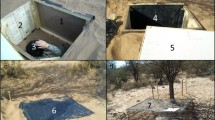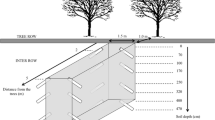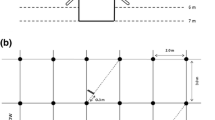Abstract
At two different sites in northern Germany, the vertical distribution patterns of roots with diameters of up to 10 mm were investigated with the trench profile wall technique beneath mature trees of Quercus petraea (Matt.) Liebl. growing on clayey (cambi-stagnic gleysol) or sandy soil (dystric cambisol). The rooting patterns were related to soil bulk density, maximum plant-available soil water and soil chemistry, and were compared with the rooting pattern of Q. petraea growing on a silty soil on limestone (luvisol) and with that of Q. robur L. growing on clayey loam (stagnic cambisol). All three Q. petraea sites differed in their vertical rooting pattern, as was indicated by significant differences in the parameter β which was calculated from the cumulative root fraction (Y) for the cumulative rooting depth (d; Y=1−βd). At the clayey site, a relatively large fraction of roots was found in deeper soil layers (highest β value); whereas, at the silty site, the rooting pattern was most superficial (lowest β value). No significant difference in the vertical rooting pattern was observed between Q. petraea and Q. robur growing on clayey soil. The soil-area related biomasses of living roots did not differ between the clayey and the sandy site of Q. petraea.Comparisons of the rooting patterns with soil water relations and soil chemistry lead to the hypothesis that under the climatic conditions of Central Europe, the vertical root distribution of Q. petraea is more influenced by the availability of nutrients, especially that of nitrogen, than by the amounts of plant-available soil water.
Similar content being viewed by others
References
Arbeitskreis Standortskartierung (ed.). 1996. Forstliche Standortsaufnahme, 5th ed., IHW-Verlag, München.
Bakker, M. R. 1999. The effect of lime and gypsum applications on a sessile oak (Quercus petraea (M.) Liebl.) stand at La Croix-Scaille (French Ardennes) II. Fine root dynamics. Plant Soil 206: 109–121.
Böhm, W. 1979. Methods of Studying Root Systems. Ecological Studies. Vol. 33. Springer-Verlag, Berlin.
Bowen, G. D. 1984. Tree roots and the use of soil nutrients. Pp. 147–179. In: Bowen, G.D. & Nambiar, E.K.S. (eds), Nutrition of Plantation Forests. Academic Press, London.
Bréda, N., Cochard, H., Dreyer, E. & Granier, A. 1993. Water transfer in a mature oak stand (Quercus petraea): seasonal evolution and effects of a severe drought. Can. J. Forest Res. 23: 1136–1143.
Büttner, V. & Leuschner, C. 1994. Spatial and temporal patterns of fine root abundance in a mixed oak-beech forest. Forest Ecol. Manag. 70: 11–21.
Cochard, H., Bréda, N., Granier, A. & Aussenac, G. 1992. Vulnerability to air embolism and hydraulic architecture of three European oak species (Quercus petraea [Matt.] Liebl., Q. pubescens Willd., Q. robur L.). Ann. Sci. Forestières 49: 225–233.
Deutscher Wetterdienst 1992–1994. Monatlicher Witterungsbericht. Deutscher Wetterdienst, Offenbach.
Eisenhauer, D. R. 1989. Untersuchungen zur Entwicklung der ökologischen Stabilität von Eichenbeständen im nordöstlichen Harzvorland. Beiträge für die Forstwirtschaft 23: 55–62.
Ellenberg, H. 1996. Vegetation Mitteleuropas mit den Alpen, 5th ed., Ulmer, Stuttgart.
Ellenberg, H., Mayer, R. & Schauermann, J. (eds), 1986. Ökosystemforschung – Ergebnisse des Sollingprojekts 1966–1986. Ulmer, Stuttgart.
Gale, M. R. & Grigal, D. F. 1987. Vertical root distributions of northern tree species in relation to successional status. Can. J. Forest Res. 17: 829–834.
Gardner, W. R. 1964. Relation of root distribution to water uptake and availability. Agron. J. 56: 41–45.
Jackson, R. B., Canadell, J., Ehleringer, J. R., Mooney, H. A., Sala, O. E. & Schulze, E.-D. 1996. A global analysis of root distributions for terrestrial biomes. Oecologia 108: 389–411.
Kalisz, P. J., Zimmerman, R.W. & Muller, R. N. 1987. Root density, abundance, and distribution in the mixed mesophytic forest of eastern Kentucky. Soil Sci. Soc. Am. J. 51: 220–225.
Köstler, J. N., Brückner, E. & Bibelriether, H. 1968. Die Wurzeln der Waldbäume. Parey, Hamburg.
Kreutzer, K. 1961. Wurzelbildung junger Waldbäume auf Pseudogleyböden. Forstwissenschaftliches Centralblatt 80: 356–392.
Kuntze, H., Roeschmann, G. & Schwerdtfeger, G. 1994. Bodenkunde, 5th ed., Ulmer, Stuttgart.
Leuschner, C., Hertel, D., Muhs, A. & Schmid, I. 1998. Feinwurzel-Bestandesmassen der Rotbuche an verschiedenen Standorten innerhalb ihrer ökologischen Amplitude in Nordwest-und Mitteldeutschland. Verh. Ges. Ökologie 28: 429–434.
Lévy, G., Becker, M. & Duhamel, D. 1992. A comparison of the ecology of pedunculate and sessile oaks: radial growth in the centre and northwest of France. Forest Ecol. Manag. 55: 51–63.
Lucot, E. & Bruckert, S. 1992. Organisation du système racinaire du chêne pédonculé (Quercus robur) développé en conditions édaphiques non contraignantes (sol brun lessivé colluvial). Ann. Sci. Forestières 49: 465–479.
Lucot, E., Badot, P.M. & Bruckert, S. 1995. Influence de l'humidité du sol et de la distribution des racines sur le potentiel hydrique du xylème dans des peuplements de chêne (Quercus sp.) de basse altitude. Ann. Sci. Forestières 52: 173–182.
Luxová, M. & Ciamporová M. 1992. Root structure. Pp. 31–81. In: Kolek, J. & Kozinka, V. (eds), Physiology of the Root System. Kluwer Academic Publishers, Dordrecht.
Meusel, H., Jäger, E. & Weinert, E. 1965. Vergleichende Chorologie der zentraleuropäischen Flora. VEB G. Fischer Verlag, Jena.
Murach, D. & Wiedemann, H. 1988. Dynamik und chemische Zusammensetzung der Feinwurzeln von Waldbäumen als Ma_ für die Gefährdung von Waldökosystemen durch toxische Luftverunreinigungen. Berichte des Forschungszentrums Waldökosysteme B 10: 1–287. Forschungszentrum Waldökosysteme, Göttingen.
Oberdorfer, E. 1990. Pflanzensoziologische Exkursionsflora, 6th ed., Ulmer, Stuttgart.
Piep, H. 1994. Untersuchungen zum Wasserhaushalt von Traubeneichenbeständen und seine Beziehung zum Eichensterben im Mitteldeutschen Trockengebiet am Beispiel des Hakel-Waldes. Diploma Thesis, Institut für Waldbau I, Fakultät für Forstwissenschaften und Waldökologie, Universität Göttingen.
Polomski, J. & Kuhn, N. 1998. Wurzelsysteme. Verlag Paul Haupt, Bern.
Richard, F., Lüscher, P. & Strobel, T. 1978. Physikalische Eigenschaften von Böden aus der Schweiz. Vol. 1. Eidgenössische Anstalt für das Forstliche Versuchswesen, Birmensdorf/ Switzerland.
Röhrig, E. 1966. Die Wurzelentwicklung der Waldbäume in Abhängigkeit von den ökologischen Verhältnissen. I. Teil. Forstarchiv 37: 217–229.
Sachs, L. 1984. Applied Statistics-A Handbook of Techniques, 2nd ed., Springer-Verlag, New York.
Sainju, U. M. & Good, R. E. 1993. Vertical root distribution in relation to soil properties in New Jersey pineland forests. Plant Soil 150: 87–97.
Schachtschabel, P., Blume, H.-P., Brümmer, G., Hartge, K.-H. & Schwertmann, U. 1992. Scheffer/Schachtschabel – Lehrbuch der Bodenkunde, 13th ed., Enke, Stuttgart.
Schmull, M. & Thomas, F. M. 1999. Auswirkungen temporärer Staunässe auf Wachstum und Wasserhaushalt junger Laubbäume (Quercus robur L., Q. petraea [Matt.] Liebl., Fagus sylvatica L.). Bielefelder Ökologische Beiträge 14: 287–292.
Strong, W.L. & La Roi, G.H. 1985. Root density-soil relationships in selected boreal forests of central Alberta, Canada. Forest Ecol. Manag. 12: 233–251.
Stubbe, M. 1971. Wald-, Wild-und Jagdgeschichte des Hakel. Archiv für Forstwesen 20: 115–204.
Thomas, F. M. & Büttner, G. 1998. Nutrient relations in healthy and damaged stands of mature oaks on clayey soils: two case studies in northwestern Germany. Forest Ecol. Manag. 108: 301–319.
Thomas, F. M. & Hartmann, G. 1996. Soil and tree water relations in mature oak stands of northern Germany differing in the degree of decline. Ann. Sci. Forestières 53: 697–720.
Thomas F. M. & Hartmann, G. 1998. Tree rooting patterns and soil water relations of healthy and damaged stands of mature oak (Quercus robur L. and Quercus petraea [Matt.] Liebl.). Plant Soil 203: 145–158.
Wagner, P. A. & Dreyer, E. 1997. Interactive effects of waterlogging and irradiance on the photosynthetic performance of seedlings from three oak species displaying different sensitivities (Quercus robur, Q. petraea and Q. rubra). Ann. Sci. Forestières 54: 409–429.
Wilmanns, O. 1993. Ökologische Pflanzensoziologie, 5th ed., Quelle & Meyer, Heidelberg.
Wood, T., Bormann, F. H. & Voigt, G. K. 1984. Phosphorus cycling in a northern hardwood forest: biological and chemical control. Science 223: 391–393.
Author information
Authors and Affiliations
Rights and permissions
About this article
Cite this article
Thomas, F.M. Vertical rooting patterns of mature Quercus trees growing on different soil types in northern Germany. Plant Ecology 147, 95–103 (2000). https://doi.org/10.1023/A:1009841921261
Issue Date:
DOI: https://doi.org/10.1023/A:1009841921261




